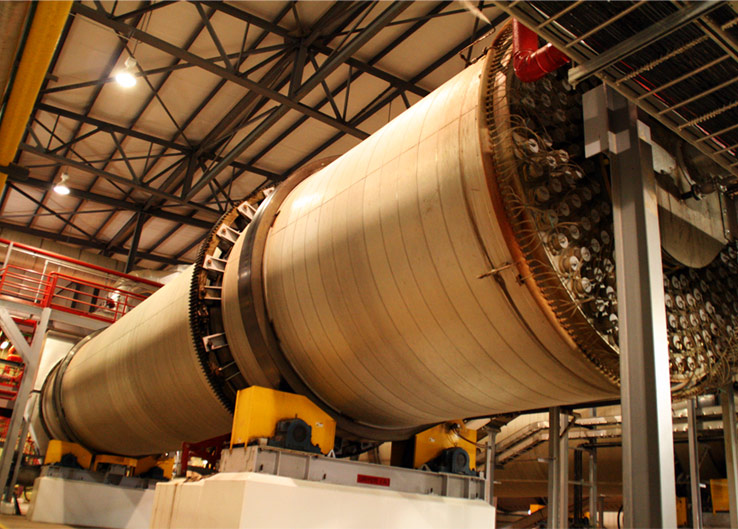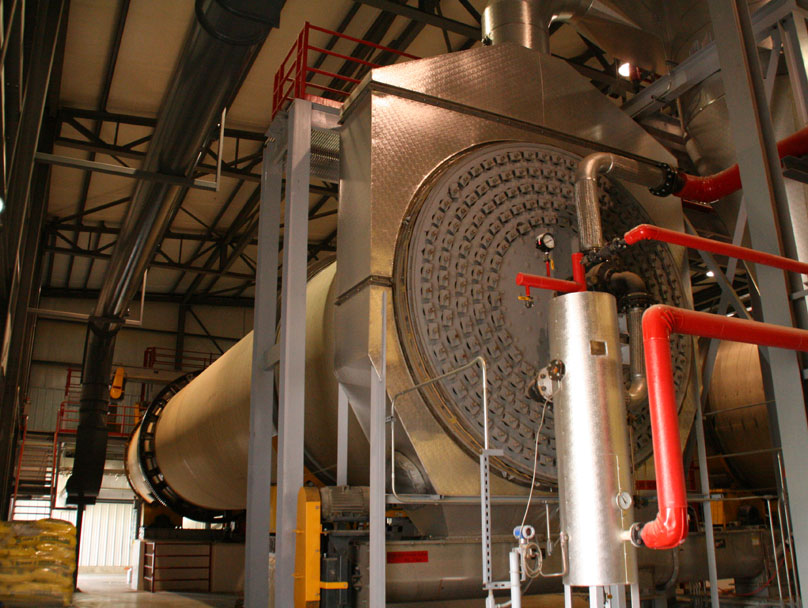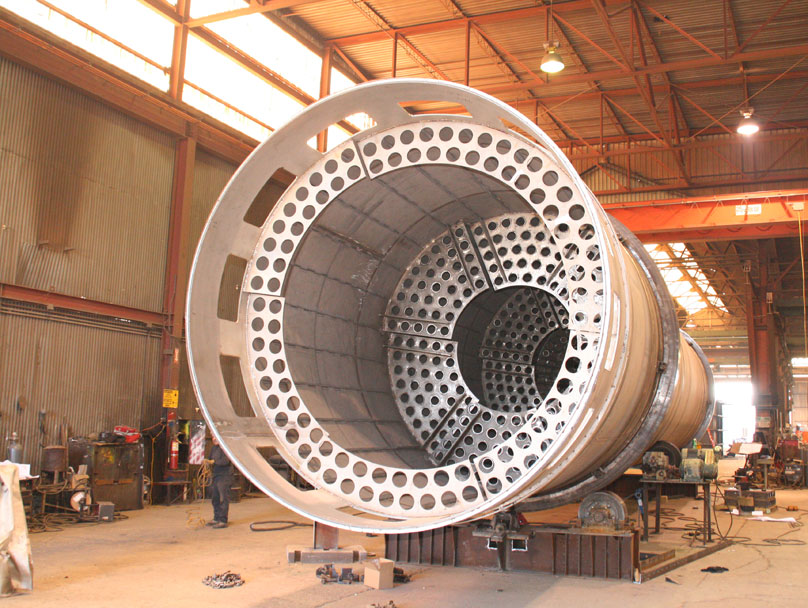Equipment Tour
Inlet
Discharge
Interior



DDLLC thrust rolls are made from forged and heat treated steel and designed with Timken tapered roller bearings. Bearing loading is calculated to assure long life. The thrust rolls are sized to limit contact stresses with the tires to a conservative level when the downhill thrust of the dryer/cooler is supported entirely by the downhill roller. Heavy-duty rolls are designed to support the full force of the shell assembly due to the dryer incline. Therefore, the trunnion rolls do not need to be canted to float the tire between the thrust rolls. DDLLC’s alignment philosophy includes aligning the trunnion rolls perpendicular to the shell axis. The result is less tire and roll wear and less complicated alignment maintenance. Ring Gears
DDLLC’s ring gears are designed to exceed the calculated tooth strength and surface endurance requirements. Forged and heat treated steel rings are machined and split into two pieces to allow for removal/reversal and replacement. Heavy-duty mounting bolt and splice plate designs assure that gear attachment/alignment will not be a routine maintenance item. DDLLC offers an automatic spray lube system for the gears that sprays a graphite/moly mixture on the gear face. Our unique attachment design locks the gear in position to assure that original tolerances are maintained during operation. Drive bases are available with heavy sub-base plates that simplify installation and future adjustments. Pinion gears are held onto the drive shafts with double locking collars. Drives can be electric motors with gearboxes or hydraulic motors attached directly to the splined drive shaft. Special features such as inverters, disc brakes and aux maintenance drives are available. Trunnion Rolls
DDLLC’s trunnion rolls are made from forged and heat treated steels such as grades 1045, 1050 and 4140. Hardness is designed to accommodate the application. DDLLC uses a time-tested formula to design the roll shafts. The shafts are precision machined with large transition radii to reduce stress risers. Shaft overhangs are minimized to reduce bending stress. Trunnion roll bearings are designed for a minimum L10 life of 3 years. Roll bases are designed with removable end plates to facilitate roll replacement. Roll bases incorporate machined bearing mounting pads to facilitate proper alignment. Shell
DDLLC’s dryer and cooler shells are designed to minimize bending stresses. Thicknesses are selected to reinforce the areas under the tires and the gear, where the forces are the greatest. Shells can be supplied from solid carbon steel, stainless steel or special alloys. Carbon steel shells with plug welded stainless steel liners are often used to benefit from the higher fatigue strength of the carbon steel while maintaining a corrosion resistant interior. Tires are located to control stress and deflection. Vent Manifold
The vent manifold collects air and non-condensable gases in the steam tubes and vents the gas out through thermostatic vents. Each steam tube is connected to the manifold by a flexible hose or tubing assembly. This system assures that the tubes remain hot throughout the entire length of the dryer. Intake Plate & Seals
The intake plate or intake hopper is a fabricated plate or housing that supports the intake seal and the feed screw or chute. It incorporates the access opening to the dryer internals. Intake seals available include Kevlar belt seals, high-temperature belt type seals, segmented synthetic resin seals and purged seals (for dryer internal pressures up to 1 PSIG). DDLLC can design the right seal for the most demanding dryer/cooler application. Sweep air enters through the plate/hopper in parallel flow applications. In counter flow applications, the sweep air is collected in and discharged through the intake hopper. Tires
DDLLC’s tires are made from forged and heat treated steel rings from grades such as 1045, 1050 & 4140 that are machined to tight tolerances. The tires are typically mounted on solid shim bands that are welded to the shell and then machined for a precise fit with the tire. DDLLC’s tire and mounting design is the result of many years of design improvements with the goal of eliminating shell cracks over the life of the dryer. DDLLC tire designs incorporate relatively low ovality ratios and tire retainers that have proven to reduce maintenance. We are happy to discuss our tire mounting philosophy with our customers. Discharge Hood & Seals
The discharge hood is a fabricated housing that collects the dried/cooled product and discharges it through a flanged outlet at the bottom, into the customer’s conveyor. The hood also collects sweep air and discharges it through a flanged opening at the top in parallel flow applications. In counter flow applications, sweep air is introduced through the discharge hood. The hood supports the discharge seals. Discharge seals available include Kevlar belt seals, high-temperature belt type seals, segmented synthetic resin seals and purged seals (for dryer internal pressures up to 1 PSIG). DDLLC can design the right seal for the most demanding dryer/cooler application. Steam Manifold
The steam manifold distributes steam to the steam tubes. It also collects the condensate from the tubes and discharges it through a rotating center pipe. Steam pressure as high as 300PSIG can be designed (however, few materials can withstand the high temperature associated with the higher pressure). DDLLC’s standard steam manifold design is a flat head design that incorporates hand holes for each tube to aid in future maintenance. Each hand hole cover and head plate gasket surface is machined to provide a superior sealing surface. All steam manifolds are designed and built to comply with ASME pressure vessel code. Pipe ring or torus ring manifolds can also be supplied if the elimination of hand hole covers is desired. Alternate designs for the chest type manifold with provisions to eliminate gasketed hand holes are also available. Rotary Joint
The rotary joint is an engineered component that introduces steam into the steam manifold and discharges condensate collected in the manifold. Self-supported joints provide simplified attachment to the manifold for easy installation and maintenance. Heavy-duty flexible hoses are furnished to isolate the rotary joint from pipe strains and to accommodate slight joint movement during operation. Product Dam
The product dam is configured in offset segments to deter the flow of dry product at the discharge end of the dryer. The offset arrangement allows the shell to be emptied out at shutdown. Some products require the dam segments to be connected, therefore, making a more effective dam. The height of the dam segments is dependent on the product being dried. Tube Supports
The tube supports are made from several segments per set. The segment plates incorporate sleeves for the steam tubes to slide through. The design and location of the support segments are carefully considered for each project. Special consideration is given to methods to reduce shell stresses where the supports are welded to the shells. Lifting Flights
The lifting flights are radial bars welded to the shell inside diameter. These lifters prevent the product from sliding on the shell. They also help lift the product as the unit rotates and therefore, cascades the product through the sweep air stream. Discharge Openings
Discharge openings are rectangular openings on the shell where the material is discharged after being processed.
